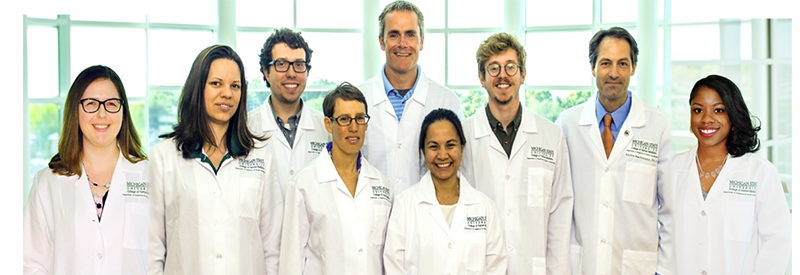
Professor, Associate Chair for Research
400 Monroe Ave NW(616) 234-2841
PubMed
International Center for Polyamine Disorders
Dr. Bachmann is a tenured Full Professor of Pediatrics at Michigan State University (MSU), College of Human Medicine (CHM) and serves as Associate Chair for Research in the Department of Pediatrics and Human Development. For the past 29 years, his research has primarily focused on ODC/polyamines and drug development in oncology. He is best known for his preclinical work with ODC inhibitor DFMO (e.g., Oncogene, 2005; Cancer Res, 2008; Biochem J, 2018; J Biol Chem, 2018), which led to the treatment of patients with relapsed/refractory neuroblastoma in phase I/II studies (PLoS One, 2015). He is credited for moving DFMO from “bench to bedside” and received the Inaugural Weinman Innovator Award for Translational Research in 2010. Since the inception of his pioneering work in 2001, DFMO (eflornithine) has entered several independent multi-center neuroblastoma phase I/II clinical studies at Children’s hospitals across the United States and abroad, through clinical trial consortia including the Children’s Oncology Group (COG) that currently conducts a randomized phase II clinical trial with neuroblastoma patients (COG-ANBL-1821).
Dr. Bachmann collaborates with medical geneticist Dr. Caleb Bupp, MD and pediatric ICU physician Dr. Surender Rajasekaran, MD at the Helen DeVos Children’s Hospital. Together, they defined a new ODC1-gene linked gain-of-function neurodevelopmental disorder, referred to as Bachmann-Bupp Syndrome (BABS) (Am J Med Genet, 2018; Biochem J, 2019; GeneReviews, 2022). In 2019, they launched the worldwide first FDA-approved single patient IND to treat this ODC1 patient with DFMO, reporting a remarkable therapeutic response (eLife, 2021). He is the Scientific Director of the newly launched “International Center of Excellence for Polyamine Disorders” (ICPD) in Grand Rapids, Michigan, USA.
Further of interest to the Bachmann lab are the discovery and development of natural products-based drugs. In collaboration with colleagues in Europe, Dr. Bachmann discovered the Syrbactin class of proteasome inhibitors (Nature, 2008), a natural product for which he holds several patents. TIR-199 is the best-in-class synthetic lead compound (J Biol Chem, 2016) that was developed by Hibiskus Biopharma, Inc., an MSU-startup company that Dr. Bachmann founded in 2017 with Dr. Michael Pirrung (UC Riverside). Hibiskus was acquired by Lodo Therapeutics, Inc, in 2020. More recently, Dr. Bachmann studied the pharmacological effects of Allicin in neuroblastoma (J Nat Prod, 2020), in collaboration with Dr. Alan Slusarenko (RWTH Aachen, Germany).

Education & Training
- MS, Microbiology, University of Zürich/ETH Zürich, Switzerland, 1994
- PhD, Biology, University of Zürich, Switzerland, 1998
- Postdoctoral Fellow, Medical Virology, University of Zürich, Switzerland, 1998-1999
- Postdoctoral Scientist, Vaccine Development, Hawaii Biotech, Inc., 1999-2001
Selected Grants
Active
- R01 HD110500, NICHD, NIH, 2023-2028
- R13 CA260996, NCI, NIH, 2023
- Spectrum Health-MSU Alliance Cooperation Grant, 2019-2023
- MSU Molecular Drug Discovery, MDG-2021-01, 2021-2023
- MSU Discretionary Funding Initiative 22-DFI-I—0000000249, 2021-2023
Past Awards (Selected)
- R21 CA216867, NCI, NIH
- R01 CA111419, NCI, NIH
- R01 ARRA Grant, NCI, NIH
- R01 CURE Grant, NCI, NIH
- St. Baldrick’s Cancer Foundation
- Alex Mandarino Foundation
- Wipe Out Kids Cancer (WOKC) Foundation
- Weinman Foundation
- Hawaii Community Foundation (HCF)
- Magic Water Foundation
Selected Peer-Reviewed Publications
- Oncogene, 2005, 24(36):5606-18
- Clinical Cancer Research, 2007, 13(21):6312-9
- Cancer Research, 2008, 68(23):9825-31
- Nature, 2008, 452(7188):755-8
- Molecular Cancer Therapeutics, 2009, 8(7):2067-75
- PNAS, 2009, 106(16):6507-12
- International Journal of Cancer, 2010, 126(9):2012-24
- Cancer Science, 2010, 101(7):1624-31
- Biochemistry, 2012, 51(34):6880-8
- Journal of Molecular Biology, 2014, 426(2):332-46
- Cellular Oncology, 2014, 37(6):387-98
- PLoS One, 2015, 10(5):e0127246
- BMC Cancer, 2015, 15:477
- Journal of Biological Chemistry, 2016, 291:8350-62
- PLoS One, 2017, 12(12):e0189044
- Bioorganic & Medicinal Chemistry, 2018, 26(2):401-12
- Biochemical Journal, 2018, 475(2):531-45
- Journal of Biological Chemistry, 2018, 293: 18757-69
- American Journal of Medical Genetics A, 2018, 176:2548-53
- Biochemical Pharmacology, 2019, 162:237-49
- Biochemical Journal, 2019, 476:2047-57
- Leukemia Research, 2020, 88:106271
- Journal of Natural Products, 2020, 83: 2518-2527
- Cancer Chemotherapy and Pharmacology, 2021, 88(4), 607-617
- eLife, 2021, 10: e67097
- Biochemical Journal, 2021, 478: 4137-4149
- ACS Omega, 2022, 7: 34665-34675
- Journal of Drug Targeting, 2022, 30: 623-633
- GeneReviews, August 25, 2022
- Biology Open, 2023, 12(3):bio059647
Patents
- Patent No. US 8,597,904 B2, 2013
- Patent No. US 9,072,778 B2, 2015
- Patent No. US 10,584,105 B2, 2020
- Patent No. US 11,273,137 B2, 2022
Awards & Honors
- Swiss National Science Foundation Award, 1994
- Siemens National Mentor Award, 2007
- Inaugural Weinman Award for Translational Research, 2010
- National Academy of Inventors (NAI), University of Hawaii Chapter, 2015
- Conference Vice Chair, Gordon Research Conference (GRC) on Polyamines, 2019
- William B. Weil, Jr., MD Endowed Distinguished Pediatric Faculty Award, 2020
- Conference Chair, Gordon Research Conference (GRC) on Polyamines, 2023
- Inventor of the Year, New York Intellectual Property Law Association, 2023
